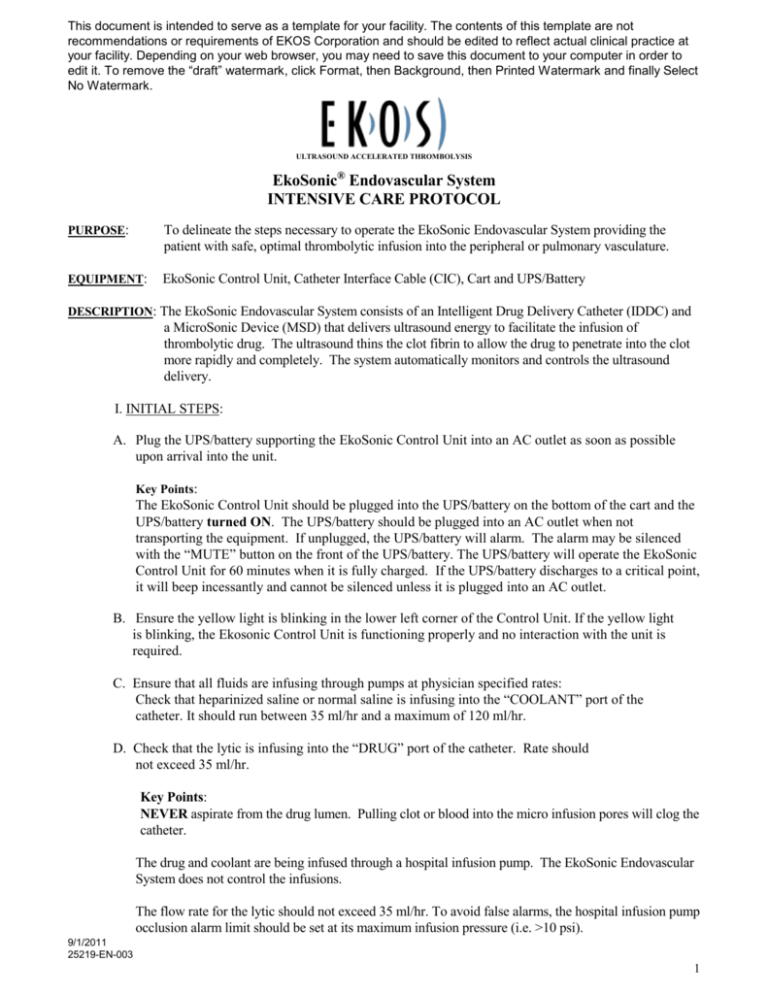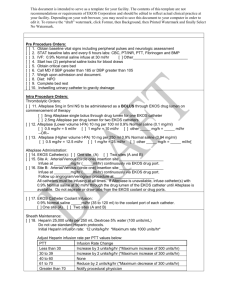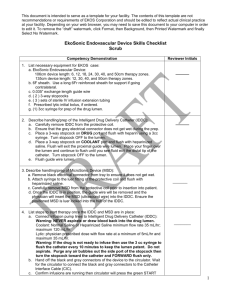ICU Protocol
advertisement

This document is intended to serve as a template for your facility. The contents of this template are not recommendations or requirements of EKOS Corporation and should be edited to reflect actual clinical practice at your facility. Depending on your web browser, you may need to save this document to your computer in order to edit it. To remove the “draft” watermark, click Format, then Background, then Printed Watermark and finally Select No Watermark. ULTRASOUND ACCELERATED THROMBOLYSIS EkoSonic® Endovascular System INTENSIVE CARE PROTOCOL PURPOSE: To delineate the steps necessary to operate the EkoSonic Endovascular System providing the patient with safe, optimal thrombolytic infusion into the peripheral or pulmonary vasculature. EQUIPMENT: EkoSonic Control Unit, Catheter Interface Cable (CIC), Cart and UPS/Battery DESCRIPTION: The EkoSonic Endovascular System consists of an Intelligent Drug Delivery Catheter (IDDC) and a MicroSonic Device (MSD) that delivers ultrasound energy to facilitate the infusion of thrombolytic drug. The ultrasound thins the clot fibrin to allow the drug to penetrate into the clot more rapidly and completely. The system automatically monitors and controls the ultrasound delivery. I. INITIAL STEPS: A. Plug the UPS/battery supporting the EkoSonic Control Unit into an AC outlet as soon as possible upon arrival into the unit. Key Points: The EkoSonic Control Unit should be plugged into the UPS/battery on the bottom of the cart and the UPS/battery turned ON. The UPS/battery should be plugged into an AC outlet when not transporting the equipment. If unplugged, the UPS/battery will alarm. The alarm may be silenced with the “MUTE” button on the front of the UPS/battery. The UPS/battery will operate the EkoSonic Control Unit for 60 minutes when it is fully charged. If the UPS/battery discharges to a critical point, it will beep incessantly and cannot be silenced unless it is plugged into an AC outlet. B. Ensure the yellow light is blinking in the lower left corner of the Control Unit. If the yellow light is blinking, the Ekosonic Control Unit is functioning properly and no interaction with the unit is required. C. Ensure that all fluids are infusing through pumps at physician specified rates: Check that heparinized saline or normal saline is infusing into the “COOLANT” port of the catheter. It should run between 35 ml/hr and a maximum of 120 ml/hr. D. Check that the lytic is infusing into the “DRUG” port of the catheter. Rate should not exceed 35 ml/hr. Key Points: NEVER aspirate from the drug lumen. Pulling clot or blood into the micro infusion pores will clog the catheter. The drug and coolant are being infused through a hospital infusion pump. The EkoSonic Endovascular System does not control the infusions. The flow rate for the lytic should not exceed 35 ml/hr. To avoid false alarms, the hospital infusion pump occlusion alarm limit should be set at its maximum infusion pressure (i.e. >10 psi). 9/1/2011 25219-EN-003 1 This document is intended to serve as a template for your facility. The contents of this template are not recommendations or requirements of EKOS Corporation and should be edited to reflect actual clinical practice at your facility. Depending on your web browser, you may need to save this document to your computer in order to edit it. To remove the “draft” watermark, click Format, then Background, then Printed Watermark and finally Select No Watermark. E. IF THE YELLOW LIGHT IS NOT BLINKING: 1. Check that the Catheter Interface Cable (CIC) is connected to the front of the EkoSonic Control Unit. . 2. Check that the Catheter Interface Cable is connected to the electrical cables of the MicroSonic Device (MSD – black wire) and the Intelligent Drug Delivery Catheter (IDDC- gray wire). Key Points: Red circles on the Control Unit schematic screen will denote any areas of a loose or missing connection. 3. Check to see if the lytic drug and coolant infusions are flowing. If both infusions are flowing, press the green START button on the front of the EkoSonic Control Unit. Confirm the yellow light at the bottom left begins to flash. II. MAINTENANCE: A. The RN will request that the physician complete the routine thrombolytic orders. B. Whenever checking on the patient, look at the EkoSonic Control Unit to ensure the yellow light is blinking. Key Points: If the yellow light is blinking, the Control Unit is functioning properly and no interaction with the unit is required. If the yellow light is not blinking, see section E in INITIAL STEPS above. C. Follow the physician orders for thrombolytics regarding lab tests, sedation, IV/IA site management, sheath maintenance, vitals and neuro checks, etc. D. If thrombolytic drug must be discontinued for any reason, run NS KVO through the DRUG and COOLANT ports. Do not completely stop infusing through the DRUG and COOLANT ports. Turn ultrasound OFF by pressing the yellow stop button on the control unit and disconnect the black and gray cables from the Catheter Interface Cable (CIC). Confirm KVO orders with the interventionalist when thrombolytic drug is stopped. This will help maintain patency of the catheter in the event that the thrombolytic drug and ultrasound can be restarted. III. TROUBLESHOOTING: A. If the Control Unit alarm sounds due to a disconnected cable: 1. Silence alarm by pressing the soft key beside the alarm icon (located in the top right hand corner of the screen). 2. Identify corresponding red circle on the schematic screen of the EkoSonic Control Unit. 3. Check all connections: a. Catheter Interface Cable (CIC) to the EkoSonic Control Unit b. The black and gray cables of the MicroSonic Device (MSD) and Intelligent Drug Delivery Catheter (IDDC) to the CIC according to the color code and symbol. 4. Restart ultrasound by pressing the green “START” button on the EkoSonic Control Unit. 9/1/2011 25219-EN-003 2 This document is intended to serve as a template for your facility. The contents of this template are not recommendations or requirements of EKOS Corporation and should be edited to reflect actual clinical practice at your facility. Depending on your web browser, you may need to save this document to your computer in order to edit it. To remove the “draft” watermark, click Format, then Background, then Printed Watermark and finally Select No Watermark. B. If the alarm sounds for any other reason: 1. Silence alarm by pressing the soft key beside the alarm icon (located in the top right hand corner of the screen). 2. Identify the cause for alarm by locating the troubleshooting icon that is blinking at the bottom of the screen. 3. Locate explanation for icon in the Instructions For Use book kept in the back pocket of the cart. 4. Follow Instructions For Use (IFU) suggestions OR call EKOS Helpline at 1-888-356-7435 Key Points: An Instructions for Use (IFU) Guide is provided by EKOS Corporation and there is a troubleshooting section in the operations manual which accompanies the EkoSonic Control Unit. If you are unable to correct the alarm, leave ultrasound OFF and continue infusions. Immediately contact the EKOS Helpline at 1-888-356-7435. EKOS representatives will make recommendations that are within the manufacturers IFU for trouble-shooting. The interventionalist should be contacted if there are any patient-related issues. If unable to resolve the problem through the Helpline, contact the interventional physician to determine the next steps to follow. If unable to restart the EKOS Control Unit, it is best to run fluids KVO through the COOLANT catheter port to maintain patency of the catheter. IV. PREPARATION FOR TRANSPORT: A. Unplug the EKOS system from the wall. The UPS/battery will alarm when it is unplugged. Press the “MUTE” button on the front of the UPS/battery to silence the alarm. B. The patient is now ready to be transported, while the EkoSonic and the infusion pumps remain ON. C. Upon arrival at destination, plug the EKOS system back into an AC outlet as soon as possible to maintain battery charge. 9/1/2011 25219-EN-003 3







